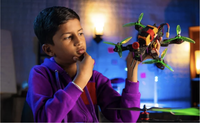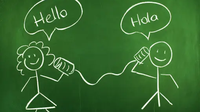Education’s digital transition seems to be taking its toll on everyone involved. Is it just growing pains, or are we sliding down a slope from which we can never ascend?
Is technology the savior of education, or a pervasive evil transforming our idyllic educational institutions?
The digital transition requires large investments of capital, and administrators are charged with both finding this capital and deciding how it is to be used. They also have the responsibility of justifying their actions if test scores don’t improve—or worse, if test scores decline.
Teachers, on the other hand, are experiencing a skyrocketing workload.
Many are exhausted.
In fact, our own Learning Counsel research found that 25 percent of instructors’ time is now spent on searching for digital curriculum or custom building a digital lesson plan.
Additionally, many of these same instructors claim to be spending a lot more hours working. In a Guardian Teacher Network survey, 82 percent said their workload was unmanageable, and about 3/4 said their workload was affecting their physical and their mental health.
More is Less
So, what is the path forward? How do we know when it’s too much?
It may surprise you, but the problem isn’t too much technology, it’s not enough.
And not by just a little.
Most non-technical teachers and administrators cannot see what’s missing; they only see what is there now. The fact is, there isn’t enough technology in education by an exponential amount.
What’s missing is an autonomous digitally-oriented alternative with full coverage of all subjects that has learner centricity as its very first and only relevant precept. It should have the same level of dazzle as the biggest online shopping sites, media hubs and consumer games mixed in with the best of machine intelligence, online chat or telecommuting teachers-on-demand yet crafted.
Properly implemented technology allows for individual content and lines of questioning to build from foundations around an individual learner, indicating the governing form, the human interactions required, the time, any physical convening space needed and speed of delivery. It would leverage technology directly, without consideration for the existing institutional or traditional teacher-learner structure.
Sound unlikely? Maybe not.
Consumer-side learning has shown that if you build it, they will come. That is evident from the massive followings online by learning apps and sites. To accomplish this, there are a couple of tricky parts. The most significant of these is the burgeoning capability of intelligent learning engines. Although not truly artificial intelligence, our machines are getting pretty darn smart.
For example, instead of using the brute force of Deep Blue, as in the IBM program that defeated chess champion Garry Kasparov over twenty years ago, new programs go beyond encyclopedic databases of potentialities and strategies that use superior code-crunching aimed at overwhelming with sheer power.
Now, intelligence engines are built in a layered approach analogous to how the human mind operates. Each layer is an artificial set of algorithms that recognizes patterns, similar in theory to a neural network using a lot of big data and when layered on each other, can form constructs and evaluations. Each layer passes up to another layer in a decision chain that acts like a human brain. These new capabilities are known as “deep learning” because of the layering. Super-fast computing makes the massive crunching of ever-more layers of data easier than ever before. This is the up-and-coming age of teaching and learning in just the next few years. The current IBM version is called Watson, and, like some of the programs emerging in the education field, leans on this idea of machine learning.
The Administrator’s Role
Many leaders look at these shifts and see “techie” teachers using new tools and understand that their role and function must change. They understand they must harness this new power but have little knowledge of how to do that. Most do not yet have the concept of tech being ubiquitous, a sort of “it’s everywhere approach” in the function of education, they don’t even expect it. But other leaders in the field are now starting to talk like that, at least from an infrastructure viewpoint.
According to Lenny Schaad, former Chief Technology Information Officer at Houston ISD, “Technology in a school needs to be as simple and expected as light when you flick a light switch. Nobody thinks about it. When I walk into my office and I hit my lights, I want them on, and when I walk out the door and I’m not using it, then I don’t care about it,” he says. “We need to be that invisible. You get your seat at the table by supporting teaching and learning by being invisible and always on. In fact, it’s above and beyond even that because you need to also redefine ways in which you’re improving and making more efficient, the teaching and learning process.”
What’s Next?
Ideally, if we had a digital-transition-in-education model, with the ability to incubate a networked system that will work and an experimental playing field bolstered by public funding, we could work this out. Alternatively, the private sector could do this just as well.
Some of the work has been done with fully online charters attached to the state level as in California, but those do not seem to have a social support structure. Those students enrolled are opted out of all physical local interaction and have literally “left the building” to join a sort of unschool that is still a school, but totally virtual, with remote teachers-by-Internet. The online virtual school is still a bit flat in terms of the technical software sophistication.
Additionally, a trade-off of sports, arts, and social interaction is made to go fully online that is perhaps unnecessary. The thing being proposed with the consumerization of learning—a highly actualized digital learning journey completely customized to fit a student with a high degree of quality digital experience, but not necessarily with physical or social experience—will also miss the point that many online charters miss.
The next thing needed is a strategic plan that would encompass a role and responsibility shift for everyone at a gradual-enough scale that all the current players in the education scene could follow the path to give the best of both worlds, blended together in a wonderful orchestration. It is entirely possible with the right planning on a national scale. The war for the survival of public schools has begun. The number of people arguing about public education and whether charter schools should be allowed to survive and people experimenting with alternatives has never been greater. The number of school opt-outers of various types is accelerating and has never been higher.
Many people believe that public education is so embedded in our psyches that it is a certainty, like death and taxes. But as more people discover alternatives, and especially the simplicity of a tech-delivered alternative, there is the danger that a negative momentum will build. That negativity has the power to kill public education or force ever more brutal reforms.
New Forms and Structures
What’s indicated now that we are in the Age of Experience is a consensus network structure similar to those that are already evident in other industries. For education, such a network would knit together the best subject experts, curate knowledge and facilitate individual students to maneuver through the basics they must know and everything else they want to know. It should focus on the creation of real experiences, both digital and otherwise.
Using courseware, teacher guides can lead the student to a completely individualized point of entry and a personalized path. What is currently missing from the existing structure is less human interaction in the things that are common points of knowledge that can be taught by tech, and more human interactions on being human, being moral and being social. That will balance what is currently missing from the existing structure.
About the Author

Leilani Cauthen is CEO of the Learning Counsel and author of “The Consumerization of Learning.” Contact her through www.learningcounsel.com
This article originally appeared on EdTech Digest.











